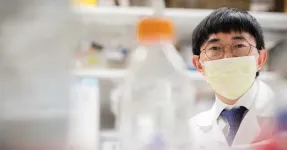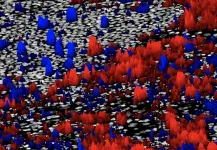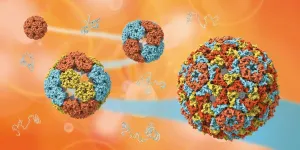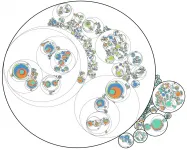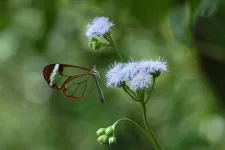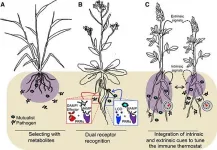(Press-News.org) June 10, 2021, CLEVELAND: A new Cleveland Clinic-led study has identified mechanisms by which COVID-19 can lead to Alzheimer's disease-like dementia. The findings, published in Alzheimer's Research & Therapy, indicate an overlap between COVID-19 and brain changes common in Alzheimer's, and may help inform risk management and therapeutic strategies for COVID-19-associated cognitive impairment.
Reports of neurological complications in COVID-19 patients and "long-hauler" patients whose symptoms persist after the infection clears are becoming more common, suggesting that SARS-CoV-2 (the virus that causes COVID-19) may have lasting effects on brain function. However, it is not yet well understood how the virus leads to neurological issues.
"While some studies suggest that SARS-CoV-2 infects brain cells directly, others found no evidence of the virus in the brain," says Feixiong Cheng, Ph.D., assistant staff in Cleveland Clinic's Genomic Medicine Institute and lead author on the study. "Identifying how COVID-19 and neurological problems are linked will be critical for developing effective preventive and therapeutic strategies to address the surge in neurocognitive impairments that we expect to see in the near future."
In the study, the researchers harnessed artificial intelligence using existing datasets of patients with Alzheimer's and COVID-19. They measured the proximity between SARS-CoV-2 host genes/proteins and those associated with several neurological diseases where closer proximity suggests related or shared disease pathways. The researchers also analyzed the genetic factors that enabled SARS-COV-2 to infect brain tissues and cells.
While researchers found little evidence that the virus targets the brain directly, they discovered close network relationships between the virus and genes/proteins associated with several neurological diseases, most notably Alzheimer's, pointing to pathways by which COVID-19 could lead to AD-like dementia. To explore this further, they investigated potential associations between COVID-19 and neuroinflammation and brain microvascular injury, which are both hallmarks of Alzheimer's.
"We discovered that SARS-CoV-2 infection significantly altered Alzheimer's markers implicated in brain inflammation and that certain viral entry factors are highly expressed in cells in the blood-brain barrier," explained Dr. Cheng. "These findings indicate that the virus may impact several genes or pathways involved in neuroinflammation and brain microvascular injury, which could lead to Alzehimer's disease-like cognitive impairment."
The researchers also found that individuals with the allele APOE E4/E4, the greatest genetic risk factor for Alzheimer's, had decreased expression of antiviral defense genes, which could make these patients more susceptible to COVID-19.
"Ultimately, we hope to have paved the way for research that leads to testable and measurable biomarkers that can identify patients at the highest risk for neurological complications with COVID-19," said Dr. Cheng.
Dr. Cheng and his team are now working to identify actionable biomarkers and new therapeutic targets for COVID-19-associated neurological issues in COVID long-haulers using cutting-edge network medicine and artificial intelligence technologies.
INFORMATION:
Yadi Zhou, Ph.D.; Jielin Xu, Ph.D., and Yuan Hou, Ph.D., are co-first authors on the study. The study was supported by the National Institute on Aging, the National Heart, Lung, and Blood Institute; the National Institute of Neurological Disorders and Stroke, and Cleveland Clinic's VeloSano Pilot Program.
About Cleveland Clinic
Cleveland Clinic - now in its centennial year - is a nonprofit multispecialty academic medical center that integrates clinical and hospital care with research and education. Located in Cleveland, Ohio, it was founded in 1921 by four renowned physicians with a vision of providing outstanding patient care based upon the principles of cooperation, compassion and innovation. Cleveland Clinic has pioneered many medical breakthroughs, including coronary artery bypass surgery and the first face transplant in the United States. U.S. News & World Report consistently names Cleveland Clinic as one of the nation's best hospitals in its annual "America's Best Hospitals" survey. Among Cleveland Clinic's 70,800 employees worldwide are more than 4,660 salaried physicians and researchers, and 18,500 registered nurses and advanced practice providers, representing 140 medical specialties and subspecialties. Cleveland Clinic is a 6,500-bed health system that includes a 173-acre main campus near downtown Cleveland, 19 hospitals, more than 220 outpatient facilities, and locations in southeast Florida; Las Vegas, Nevada; Toronto, Canada; Abu Dhabi, UAE; and London, England. In 2020, there were 8.7 million total outpatient visits, 273,000 hospital admissions and observations, and 217,000 surgical cases throughout Cleveland Clinic's health system. Patients came for treatment from every state and 185 countries. Visit us at END
The human heart contracts about 70 times per minute, while that of a rat contracts over 300 times; what accounts for this difference? In a new study publishing 10th June in the open-access journal PLOS Biology, led by Michael Geeves and Mark Wass of the University of Kent and Leslie Leinwand from the University of Colorado Boulder, reveal the molecular differences in the heart muscle protein beta myosin that underly the large difference in contraction velocity between the two species.
Myosin is a "molecular motor" - an intricate nanomachine that forms the dynamic core of a muscle's contractile machinery, burning ...
Pairing sky-mapping algorithms with advanced immunofluorescence imaging of cancer biopsies, researchers at The Mark Foundation Center for Advanced Genomics and Imaging at Johns Hopkins University and the Bloomberg~Kimmel Institute for Cancer Immunotherapy developed a robust platform to guide immunotherapy by predicting which cancers will respond to specific therapies targeting the immune system.
A new platform, called AstroPath, melds astronomic image analysis and mapping with pathology specimens to analyze microscopic images of tumors.
Immunofluorescent imaging, using antibodies with fluorescent tags, enables researchers to visualize multiple cellular proteins simultaneously and determine their pattern and strength of expression. Applying AstroPath, ...
The team say their findings have implications for the treatment of viruses in future.
Researchers from the Universities of York and Leeds, collaborating with the Hilvert Laboratory at the ETH Zürich, studied the structure, assembly and evolution of a 'container' composed of a bacterial enzyme.
The study - published in the journal Science - details the structural transformation of these virus-like particles into larger protein 'containers'.
It also reveals that packaging of the genetic cargo in these containers becomes more efficient during the later stages of evolution. They show that this is because the genome inside evolves hallmarks of a mechanism widely ...
The specific traits of a plant's roots determine the climatic conditions under which a particular plant prevails. A new study led by the University of Wyoming sheds light on this relationship -- and challenges the nature of ecological trade-offs.
Daniel Laughlin, an associate professor in the UW Department of Botany and director of the Global Vegetation Project, led the study, which included researchers from the German Centre for Integrative Biodiversity Research in Leipzig, Germany; Leipzig University; and Wageningen University & Research in Wageningen, Netherlands.
"We found that root traits can explain species distributions across the planet, which has never been attempted ...
It's often cancer's spread, not the original tumor, that poses the disease's most deadly risk.
"And yet metastasis is one of the most poorly understood aspects of cancer biology," says Kamen Simeonov, an M.D.-Ph.D. student at the University of Pennsylvania Perelman School of Medicine.
In a new study, a team led by Simeonov and School of Veterinary Medicine professor Christopher Lengner has made strides toward deepening that understanding by tracking the development of metastatic cells. Their work used a mouse model of pancreatic cancer and cutting-edge techniques to trace the lineage and gene expression patterns of individual cancer cells. They found a spectrum of aggression in the cells that arose, with cells ...
WOODS HOLE, Mass. -- Many animals have evolved camouflage tactics for self-defense, but some butterflies and moths have taken it even further: They've developed transparent wings, making them almost invisible to predators.
A team led by Marine Biological Laboratory (MBL) scientists studied the development of one such species, the glasswing butterfly, Greta oto, to see through the secrets of this natural stealth technology. Their work was published in the Journal of Experimental Biology.
Although transparent structures in animals are well established, they appear far more often in ...
Because of a phenomenon called gravitational locking, the Moon always faces the Earth from the same side. This proved useful in the early lunar landing missions in the 20th century, as there was always a direct line of sight for uninterrupted radiocommunications between Earth ground stations and equipment on the Moon. However, gravitational locking makes exploring the hidden face of the moon--the far side--much more challenging, because signals cannot be sent directly across the Moon towards Earth.
Still, in January 2019, China's lunar probe Chang'e-4 marked the first time a spacecraft landed on the far side of the Moon. Both the lander and the lunar rover it carried have been gathering and sending back images and ...
Philadelphia, June 10, 2021 - A new study from researchers at Children's Hospital of Philadelphia (CHOP) and the University of Pennsylvania's Annenberg Public Policy Center found that 18- to 24-year-olds who use cell phones while driving are more likely to engage in other risky driving behaviors associated with "acting-without-thinking," a form of impulsivity. These findings suggest the importance of developing new strategies to prevent risky driving in young adults, especially those with impulsive personalities. The study was recently published in the International Journal of Environmental Research Public Health.
Cell phone use while driving has been linked to increased crash and near-crash risk. Despite bans on handheld cell phone use ...
Plants are constantly exposed to microbes: pathogens that cause disease, commensals that cause no harm or benefit, and mutualists that promote plant growth or help fend off pathogens. For example, most land plants can form positive relationships with arbuscular mycorrhizal fungi to improve nutrient uptake. How plants fight off pathogens without also killing beneficial microbes or wasting energy on commensal microbes is a largely unanswered question.
In fact, when scientists within the field of Molecular Plant-Microbe Interactions were asked to come up with their Top 10 Unanswered Questions, the #1 question was "How do plants engage with beneficial microorganisms while at the same time restricting ...
MORGANTOWN, W.Va. -- Imagine being woken up at 3 a.m. to navigate a corn maze, memorize 20 items on a shopping list or pass your driver's test.
According to a new analysis out of West Virginia University, that's often what it's like to be a rodent in a biomedical study. Mice and rats, which make up the vast majority of animal models, are nocturnal. Yet a survey of animal studies across eight behavioral neuroscience domains showed that most behavioral testing is conducted during the day, when the rodents would normally be at rest.
"There are these dramatic daily fluctuations--in metabolism, in immune function, in learning and ...
